2.1 Examples of the Third Sector in practice
Historical examples might include medieval monasteries providing healthcare and support for those in need (Thane, 2011) or the work of the various Joseph Rowntree Trusts in the provision of housing, education and other supports in the 19th and 20th centuries.
Similarly, in more modern times it is not uncommon for private sector organisations to provide services such as waste collection that were once provided by local authorities or for third-sector organisations to provide social housing or care for children with disabilities.
From a community empowerment perspective it is crucial to note that while most discussions of engagement with the third-sector relate to larger third-sector organisations which have a national or even international profile, the reality is that most are quite small. The UK Civil Society Almanac 2019 (NCVO, 2019) indicates that of the almost 167,000 charities in the UK, 47% of charities have an annual income of less than £10,000. By contrast, less than half a percent (or 708 organisations) have annual income of over £10 million. Interestingly, this same research (NCVO, 2019) has shown that on average the largest source of funding for third-sector organisations is donations and support from the public.
What this clearly indicates is the importance of stakeholder engagement and active citizenship, most particularly by enhancing volunteering and the level of community empowerment overall.
